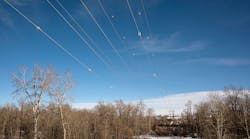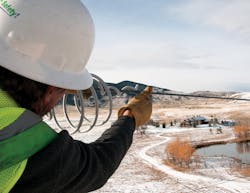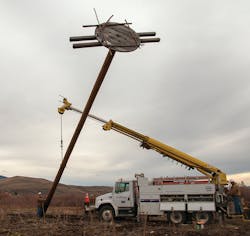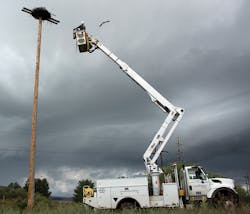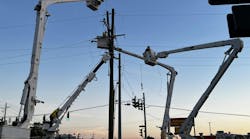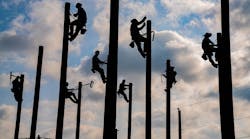This spring, as golden eagles spread their wings and soar across the landscape searching for prey or perhaps a mate, they will find Montana a safer place as they return to their territories. More than 30 years ago, the Edison Electric Institute’s Avian Power Line Interaction Committee (APLIC) collaborated with the U.S. Fish & Wildlife Service (USFWS) to create several guidance documents, which the utility industry and agencies rely on to protect birds and infrastructure and to maintain a high level of customer service.
Eagles, and nearly every other bird species, are protected by federal laws administered by the USFWS including the Migratory Bird Treaty Act, the Bald and Golden Eagle Protection Act and the Endangered Species Act. Dangers to birds from power lines include electrocution or collision. These interactions may cause outages and equipment damage resulting in service interruptions for customers. Several species including ospreys, hawks, eagles or ravens may also build nests on power poles.
Utilities can follow APLIC Avian Protection Plan (APP) guidelines released in 2005, in concert with USFWS, to address these challenges. Companies develop APPs voluntarily to address risks found within a unique service territory rather than a one-size-fits-all approach. As part of the APP process, utilities follow APLIC guidelines for electrocution and collision prevention to develop internal avian-friendly construction standards and policies.
Creating a Partnership
In Montana, the USFWS, Montana Fish Wildlife and Parks (MT FWP), NorthWestern Energy, the Montana Electric Cooperatives’ Association (MECA), Western Area Power Administration, Montana-Dakota Utilities, universities, researchers and Audubon followed the collaborative process developed by the APLIC-USFWS partnership and worked together to protect birds and electric infrastructure.
For example, the entities jointly hosted APLIC avian protection workshops to provide education, developed an informal network to find out who owns which lines when problems are identified, supported research and shared information. Today, they call on one another to find solutions to specific problems. As a result, all but a small percentage of power lines in Montana are covered by APPs.
Following a second APLIC workshop in 2014, MECA hired a consultant, Burns & McDonnell, to develop a first-of-its-kind, statewide APP covering all member coops, which manage 56,000 miles of power lines. Originally, each coop agreed to modify the APP to meet conditions in their service territories and operations. Rather than modify the statewide APP for 22 cooperatives, however, Burns & McDonnell recommended developing an “implementation plan” for each member, and the coops and agencies approved this approach.
MECA’s statewide APP was approved in 2016, and the last of 22 implementation plans were recently given the green light, making Montana the first state with an APP for every electric cooperative based in the state. MECA members are now putting their implementation plans into action by training their employees on the APP, identifying existing risky poles and taking corrective actions. They are also building new electrical facilities using bird-friendly construction designs and communicating these efforts to MECA and the resources agencies they work with regularly.
Shortly after joining APLIC, NorthWestern Energy, in consultation with USFWS and MT FWP, developed a Raptor Protection Policy in 1998. It included policies, construction standards meeting APLIC guidelines and an Osprey Nest Management Plan. Over time and two revisions, this document evolved into a formal APP in 2009. NorthWestern Energy is again updating and expanding its APP. Its Safety, Health and Environmental Handbook includes a chapter on raptors that provides guidance for operations employees. The utility is starting another round of training for employees this year and is currently developing a series of online training modules.
Safeguarding Against Electrocutions
Electrocution risk is increased by inadequate separation between energized components or between energized and grounded components. Other risk factors include size and age of birds, weather (wet feathers), food or prey availability, and type of bird use like hunting, roosting or nesting. While currently updating its APP, NorthWestern has long followed APLIC guidance by constructing new lines and replacement poles to meet its Raptor Standards and by retrofitting existing structures with bird protection devices and materials.
Initial efforts included installing various perch preventer designs on crossarms to deter birds from landing or perching in hazardous locations. Rather than encouraging birds to move to a safer location, however, this approach often was counterproductive.
If prey such as rabbits or prairie dogs are available, raptors will still try to perch, sometimes landing awkwardly, forcing them into contact with energized equipment. Studies showed poles with perch preventers electrocuted more birds than unprotected poles.
Today, NorthWestern focuses on isolating or insulating energized or grounded equipment and wires. Its avian-friendly construction standards for all new and replacement structures require the APLIC recommended 60 inches of separation, and all new equipment and jumpers have protective coverings installed.
Like most utilities, Northwestern has far more miles of line already in the ground than it will install or replace in the foreseeable future. Thus, its greatest risk is existing structures lacking adequate clearance to protect birds.
Options include reframing to raptor-friendly standards; installing covers on equipment bushings, cutouts and lightning arresters; and using covered bird wire or split hose for all jumpers. Some structures require phase or conductor covers, which can be installed over an insulator to cover up a section of line on either side to protect birds when they are landing or taking off. In areas with high golden eagle usage, NorthWestern Energy has installed perches well above the covered up equipment to give the birds a safe place to land.
In addition to these preventative measures, NorthWestern Energy has supported research. The utility fully funded a $50,000 radar study of bird use on the Missouri River by Montana State University researchers in a proposed power line corridor. And the company also financed a $50,000 graduate study to better understand raptor electrocutions on a portion of its system north of Billings, Montana. NorthWestern Energy also provided bucket trucks and leg bands for a Montana State University graduate study of osprey on the Missouri River.
Preventing Bird-Line Collisions
Collisions also pose a danger to an avian population. Most collisions involve waterfowl and are usually associated with lines across or near wetlands, ponds, lakes, rivers and streams, or between these areas and feeding or resting locations. Low light, night, fog, rain, snow and wind can all play a role. Strategies to reduce risk of collision include siting new lines to avoid areas preferred by these birds and not crossing preferred flight paths. Installing line-marking devices to increase visibility is effective on both new and existing lines. Designing new lines or reframing existing lines so wires are located in as few levels as possible and installing line-marking devices also reduces risk.
NorthWestern uses a variety of line-marking devices depending on the situation. Ease of access, durability, level of risk and amount of wind are some factors under consideration. In high wind areas, more durable devices are preferred. Higher risk areas warrant use of devices that incorporate movement and more color.
Where nighttime collisions are a factor, NorthWestern Energy looks for glow-in-the-dark devices. On lines crossing the Missouri River and elsewhere, the utility had to use helicopters for installation, so ease and safety of installation were important considerations.
Managing Nesting
NorthWestern follows USFWS nest guidance while managing nesting on its system to protect birds and to reduce outages and equipment damage. By far, the osprey is the most common bird nesting on NorthWestern structures. They prefer double crossarms but can be creative when building their nests, which can cause outages. In addition, the flashover can start a nest fire, which kills eggs or chicks, and may burn the top off the pole. Then the burning embers can fall and start wildfires.
NorthWestern has installed hundreds of separate osprey platforms to protect its system and to provide osprey with a safe place to nest away from energized structures. The utility installs a nest deterrent at the original location as well as at other nearby possible nesting locations. Crews also retrofit nearby structures, which do not meet standards for raptor protection since the adults and newly fledged young birds often land on these poles.
Bailing twine is a preferred nest material that causes problems for both the birds and NorthWestern Energy’s system. Osprey get tangled in twine and end up dangling when they try to fly from the nest, and every year, the utility gets several calls to rescue the osprey. As a result, the company has sent out bill mailers to educate customers about the risk of available bailing twine and how to reduce the risk it poses to osprey.
NorthWestern, Montana-Dakota Utilities and several cooperatives also provide bucket trucks for research and banding programs at the University of Montana in the Clark Fork drainage in western Montana and for Audubon in the Yellowstone drainage. These researchers have found more than 30% of nests have at least one bird, usually a chick, tangled in twine. Both programs include public outreach to reduce the amount of bailing twine available.
Reporting Avian Mortalities
Despite these proactive strategies, birds still come in contact with power lines. As recommended in APLIC guidance documents, NorthWestern has long collected information on bird mortalities on its systems. This allows the utility to identify problem configurations, evaluate the effectiveness of mitigation measures, and identify new raptor problem areas created by land-use changes, new food or prey concentrations, or other factors. As a result, NorthWestern Energy has identified and corrected problems with both retrofitting materials and methods.
NorthWestern is proud to partner with other utilities, agencies, researchers and non-governmental organizations in a statewide effort to protect Montana’s native birds and critical electric infrastructure while providing reliable, safe service for its customers.
